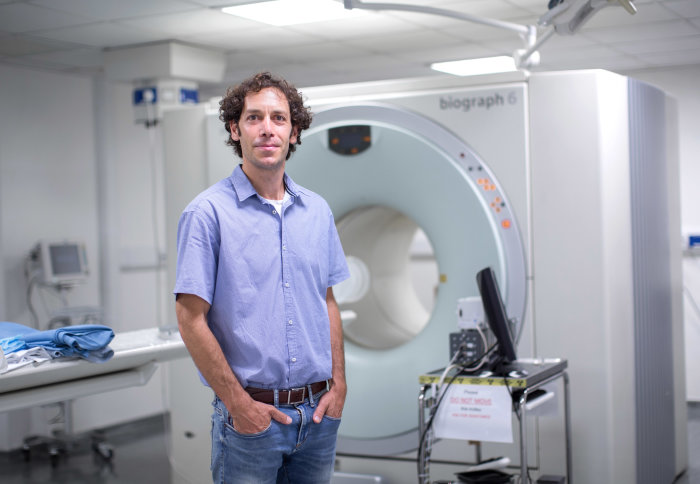Researcher wins prize for method that reaches into the brain, without surgery

Dr Nir Grossman
A technique for stimulating the brain with electrical fields could hold the key to treating a range of brain disorders.
Dr Nir Grossman, from the Department of Medicine, has been awarded the 2018 Science & PINS Prize for Neuromodulation for describing how the method, which applies small overlapping electric fields to the scalp, could one day help patients with neurological conditions for whom first line treatments do not work.
A growing body of clinical evidence shows that electrical currents can be used to target specific regions of the brain, changing their activity and helping to alleviate symptoms of some chronic conditions, such as the stiffness and tremors experienced in Parkinson’s disease.
However, this can carry risks due to its invasive nature – with electrodes having to be surgically implanted deep into the brain.

Brain stimulation
Currently, there are two main methods of brain stimulation, either internal, by implanting electrodes into the brain (called deep brain stimulation or DBS) or external, by applying a strong electrical current or electromagnetic field to the scalp (such as Transcranial Electrical Stimulation (TES) or Transcranial Magnetic Stimulation (TMS).
These external methods are unable to target regions deep in the brain without stimulating the layers above, however, including the cortical layers which regulate higher functions such as thinking and processing language.
Dr Grossman, a Fellow of the Dementia Research Institute, is investigating a non-invasive technique called temporal interference (or TI) – first described in the journal Cell last year – which he hopes could offer an alternative for huge number of patients in need, without the need for surgery and the associated complications, or interfering with higher functions.
“Deep brain stimulation has proven highly effective in treating Parkinson’s disease and obsessive-compulsive disorder, and it shows great potential for other conditions as well, such as depression,” explains Dr Grossman. “However, the process requires surgery to insert the electrodes to where they are needed, which can carry complications”.
Temporal Interference: a different approach
Dr Grossman’s method takes a different approach. Rather than directly targeting a brain region with an implanted electrode, TI uses electric fields of different frequencies to subtly ‘nudge’ brain activity.
The process involves using electrodes attached to the scalp, with small amounts of electrical current applied, generating two high frequency electric fields of slightly different frequencies.
By themselves, the electrical fields are too rapid to change the activity of the brain cells, he explains. But at the point where the two fields cross, the amplitude (or wave height) of their combined currents changes at a low frequency, and this can stimulate brain cells and subtly alter their activity.
What makes the technique so enticing is the ability to alter the point at which the fields cross, so changing the focus of the stimulation and potentially stimulating regions deep in the brain without affecting the surrounding brain areas.Early trials in mice have shown that TI can target and stimulate cells in the hippocampus, a region deep in the brain which plays important roles in memory and cognition, without affecting the cortex.
The next steps will be to test TI in healthy human volunteers, before seeing if it can work for patients with neurological conditions, and if it can match the effectiveness of DBS, but without the need for surgery.
“As TI uses well-known electrical fields and doesn’t require us to change the brain – chemically or genetically – like other methods, we hope this will speed up its clinical deployment,” explains Dr Grossman.
“This type of non-invasive stimulation could offer huge benefit to the large number of patients in need of neural therapy.”
-
The full essay ‘Modulation without surgical intervention’ is published in the journal Science.
Article images: Thomas Angus / Imperial College London
Article text (excluding photos or graphics) © Imperial College London.
Photos and graphics subject to third party copyright used with permission or © Imperial College London.
Reporter
Thomas Angus [Photographer]
Communications Division
Ryan O'Hare
Communications Division










